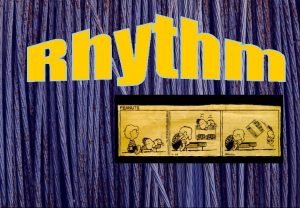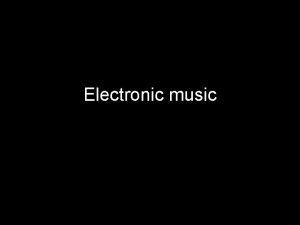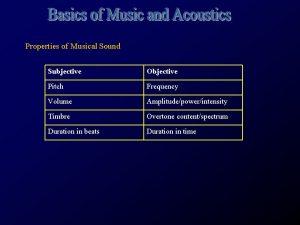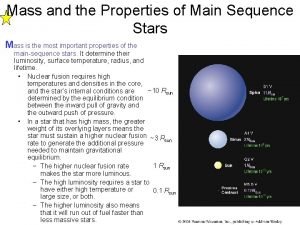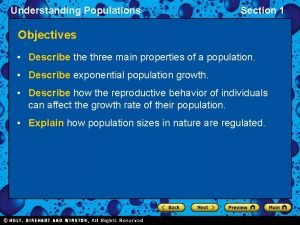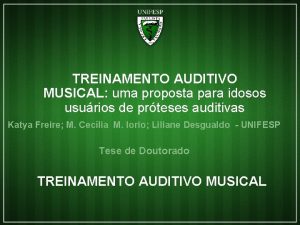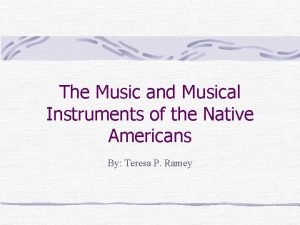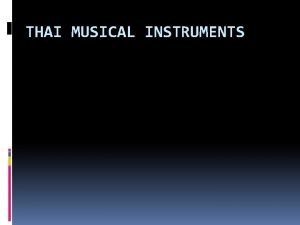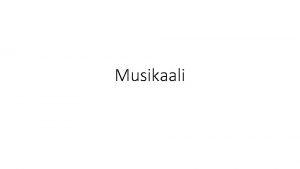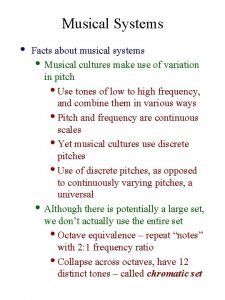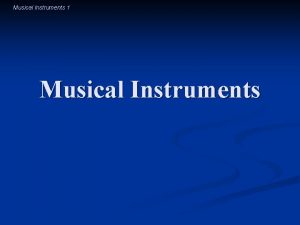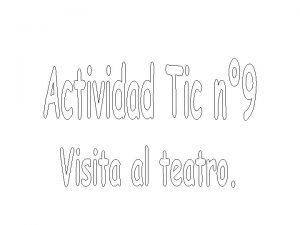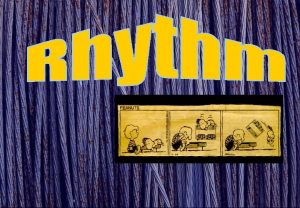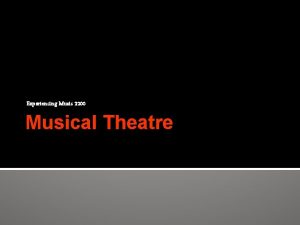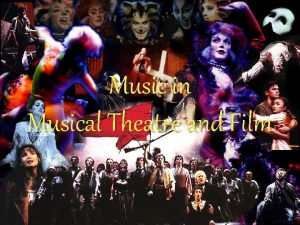What is Music 4 main properties of musical










![[i: 50] • Tie Dotted Rhythm • • Example Dotted Quarter Note a dotted [i: 50] • Tie Dotted Rhythm • • Example Dotted Quarter Note a dotted](https://slidetodoc.com/presentation_image_h/c8531b735a6bc32ef4966d515f10aad8/image-11.jpg)
![• Triplets • • • [i: 52] Rhythm divide a note into thirds • Triplets • • • [i: 52] Rhythm divide a note into thirds](https://slidetodoc.com/presentation_image_h/c8531b735a6bc32ef4966d515f10aad8/image-12.jpg)



![Rhythm Exercise [i: 53] clap the following rhythm: For each note value on the Rhythm Exercise [i: 53] clap the following rhythm: For each note value on the](https://slidetodoc.com/presentation_image_h/c8531b735a6bc32ef4966d515f10aad8/image-16.jpg)
- Slides: 16


What is Music? • 4 main properties of musical sounds: • • rhythm/duration — when to play the notes amplitude/loudness — how loud to play the notes pitch — which notes to play timbre/tone color — sound quality • which instruments are playing?

Rhythm • Rhythmic Notation • • • Sound (notes) vs. Silence (rests) Specifies starting times and durations for individual notes Staff a graph of five horizontal lines for writing musical notes (x = time, y = pitch) PITCH • TIME

Rhythm • Duration • • how long a sound lasts Note • a written symbol that shows the duration (and pitch) of a sound stem head flag

Rhythm • Beam • • the line connecting a group of flagged notes beam group = 1 beat beam

Notation of Equal Subdivisions

Rest • A short period of silence • useful for turning pages, breathing, coughing, etc.

Equal Subdivisions 1 whole note = 2 half notes = 4 quarter notes = 8 eighth notes = 16 sixteenth notes Exercise: clap the following rhythm:

Tie • Linking one note to another. • An strange article of clothing worn by Donald Tsang. = Donald Tsang

Dots • A dot increases the duration of a note by half its value • a second dot adds half the value of the first dot = =
![i 50 Tie Dotted Rhythm Example Dotted Quarter Note a dotted [i: 50] • Tie Dotted Rhythm • • Example Dotted Quarter Note a dotted](https://slidetodoc.com/presentation_image_h/c8531b735a6bc32ef4966d515f10aad8/image-11.jpg)
[i: 50] • Tie Dotted Rhythm • • Example Dotted Quarter Note a dotted note followed by a shorter note often used in marches [i: 51] Tie
![Triplets i 52 Rhythm divide a note into thirds • Triplets • • • [i: 52] Rhythm divide a note into thirds](https://slidetodoc.com/presentation_image_h/c8531b735a6bc32ef4966d515f10aad8/image-12.jpg)
• Triplets • • • [i: 52] Rhythm divide a note into thirds the notated unit is one unit smaller than the divided beat unit in an eighth-note triplet, 3 eighth notes = the duration of 1 quarter note =

Start and Duration in Csound • usually give the quarter note one beat • • start each note at the correct number of quarter notes the duration is also the correct number of quarter notes what is the start time for the 1 st note in the excerpt? what is the duration? what is the start time for the 8 th note in the excerpt? what is the duration? [i: 51]

Two Csound Parameters ; simple. sco - use with simple. orc ; name of score ; function table for waveform for sinewave oscillator f 1 0 4096 10 1 ; p 1 p 2 p 3 ; start dur i 1 0 note statement e amp 2 ; end of score p 4 Hertz p 5 4000 440 ;

Csound Score for Previous Excerpt ; simple. sco - use with simple. orc ; name of score ; function table for waveform for sinewave oscillator f 1 0 4096 10 1 ; p 1 ; . . . i 1 i 1. . . p 2 p 3 start dur amp 3 3. 75 4 . 75 . 25 p 4 Hertz p 5 . . .
![Rhythm Exercise i 53 clap the following rhythm For each note value on the Rhythm Exercise [i: 53] clap the following rhythm: For each note value on the](https://slidetodoc.com/presentation_image_h/c8531b735a6bc32ef4966d515f10aad8/image-16.jpg)
Rhythm Exercise [i: 53] clap the following rhythm: For each note value on the upper staff, write the number of the note values on the lower staff required for an equivalent duration
 Music music music
Music music music 4 main properties of music
4 main properties of music A music that employs electronic musical instruments
A music that employs electronic musical instruments Classical vs romantic art
Classical vs romantic art Is organized into recognizable/recurring accent patterns
Is organized into recognizable/recurring accent patterns What is the classification of pamulinawen?
What is the classification of pamulinawen? What are the subjective properties of music?
What are the subjective properties of music? Extensive properties and intensive properties
Extensive properties and intensive properties Physical properties and chemical properties
Physical properties and chemical properties Properties of main sequence stars
Properties of main sequence stars Describe the three main properties of a population
Describe the three main properties of a population Future time will and going to
Future time will and going to Main ideas examples
Main ideas examples Void main int main
Void main int main Treinamento auditivo musical
Treinamento auditivo musical Native american musical instruments
Native american musical instruments Piphat instrument
Piphat instrument

